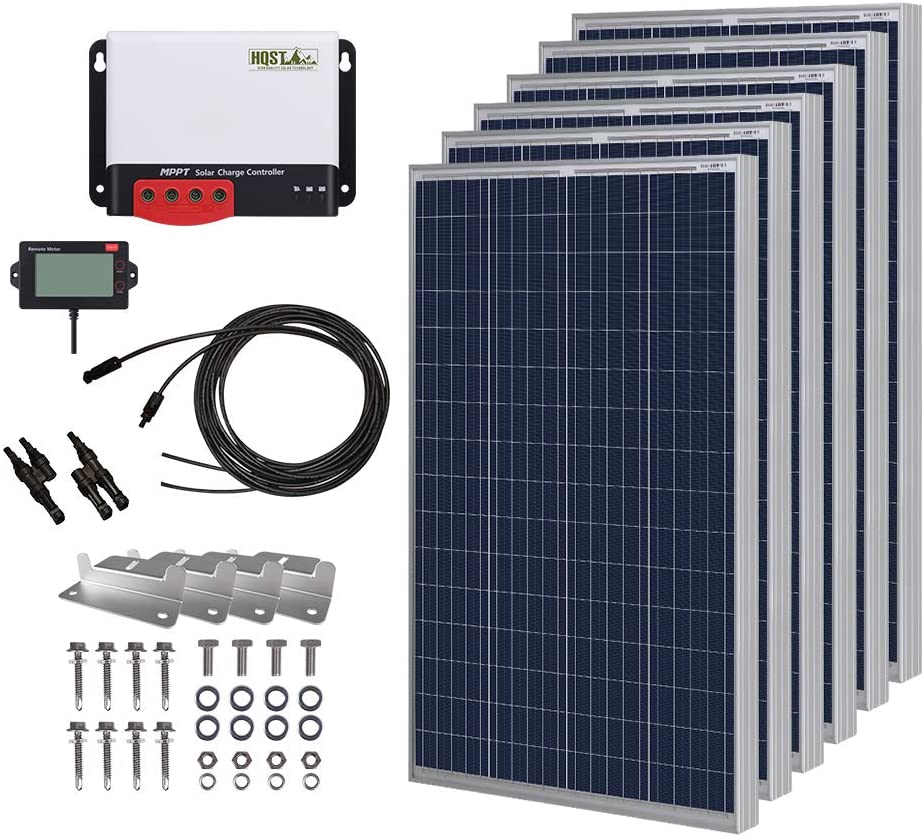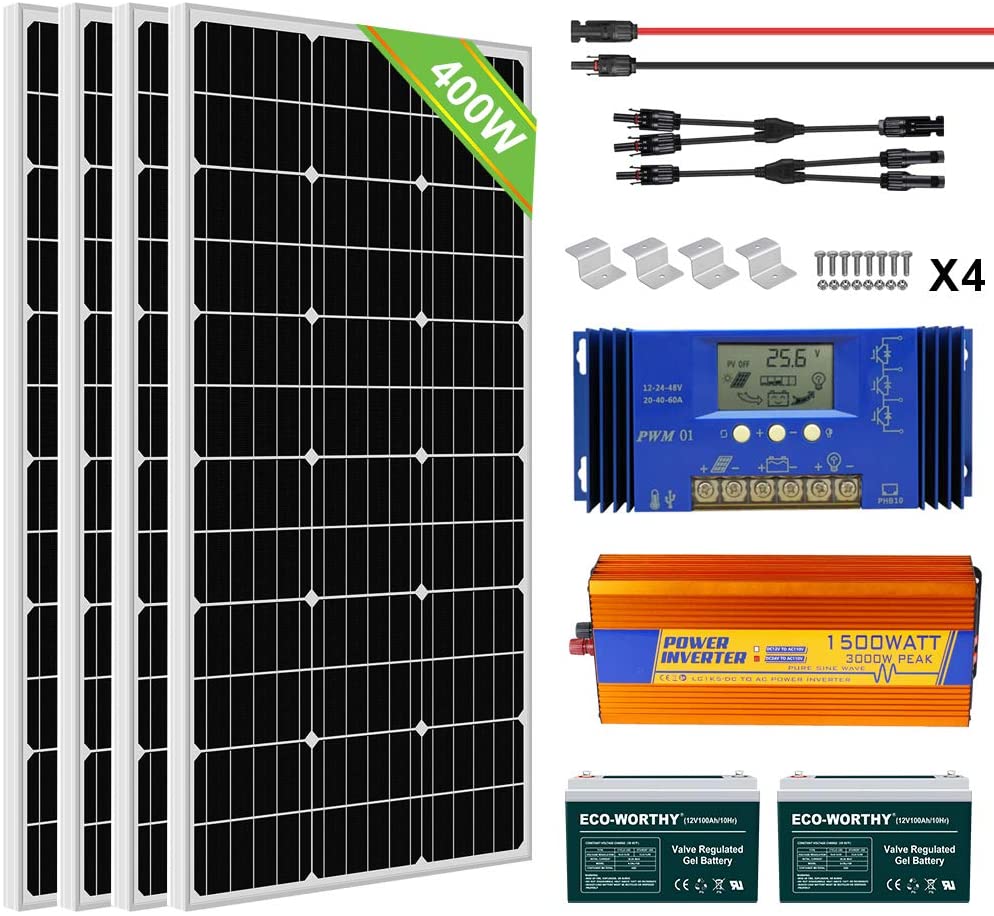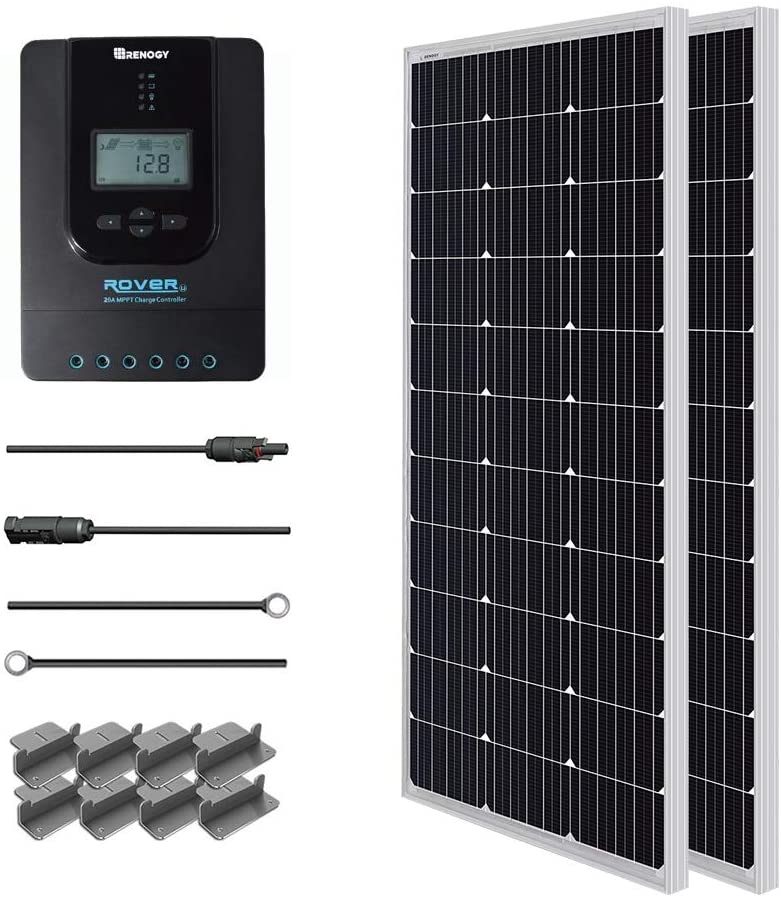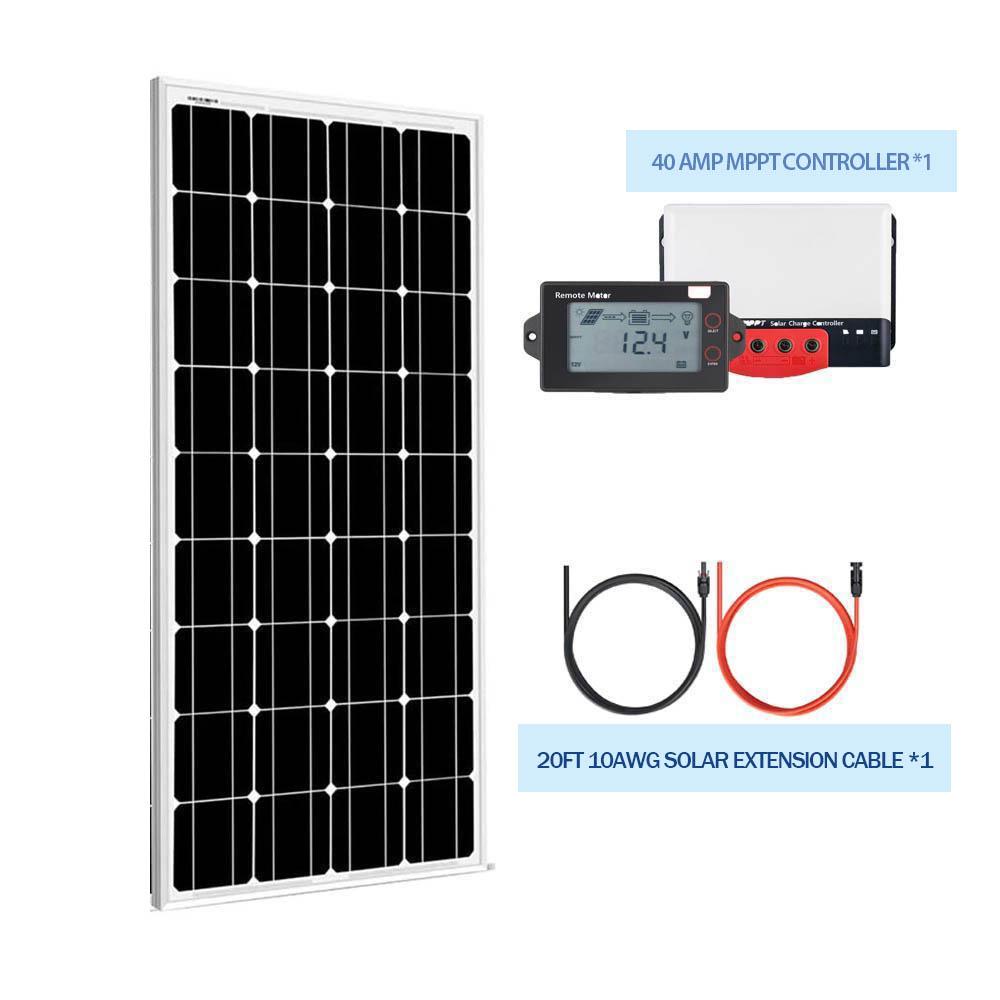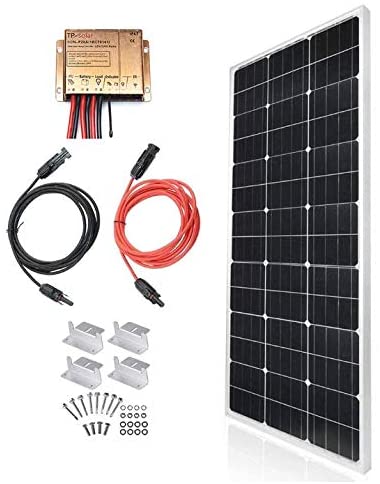Looking for the best solar panel kits for your home? Whether you’re aiming to cut your electricity bill or move toward energy independence, these top 10 kits offer the perfect blend of performance, ease of installation, and value. Let’s break down which one fits your home best.
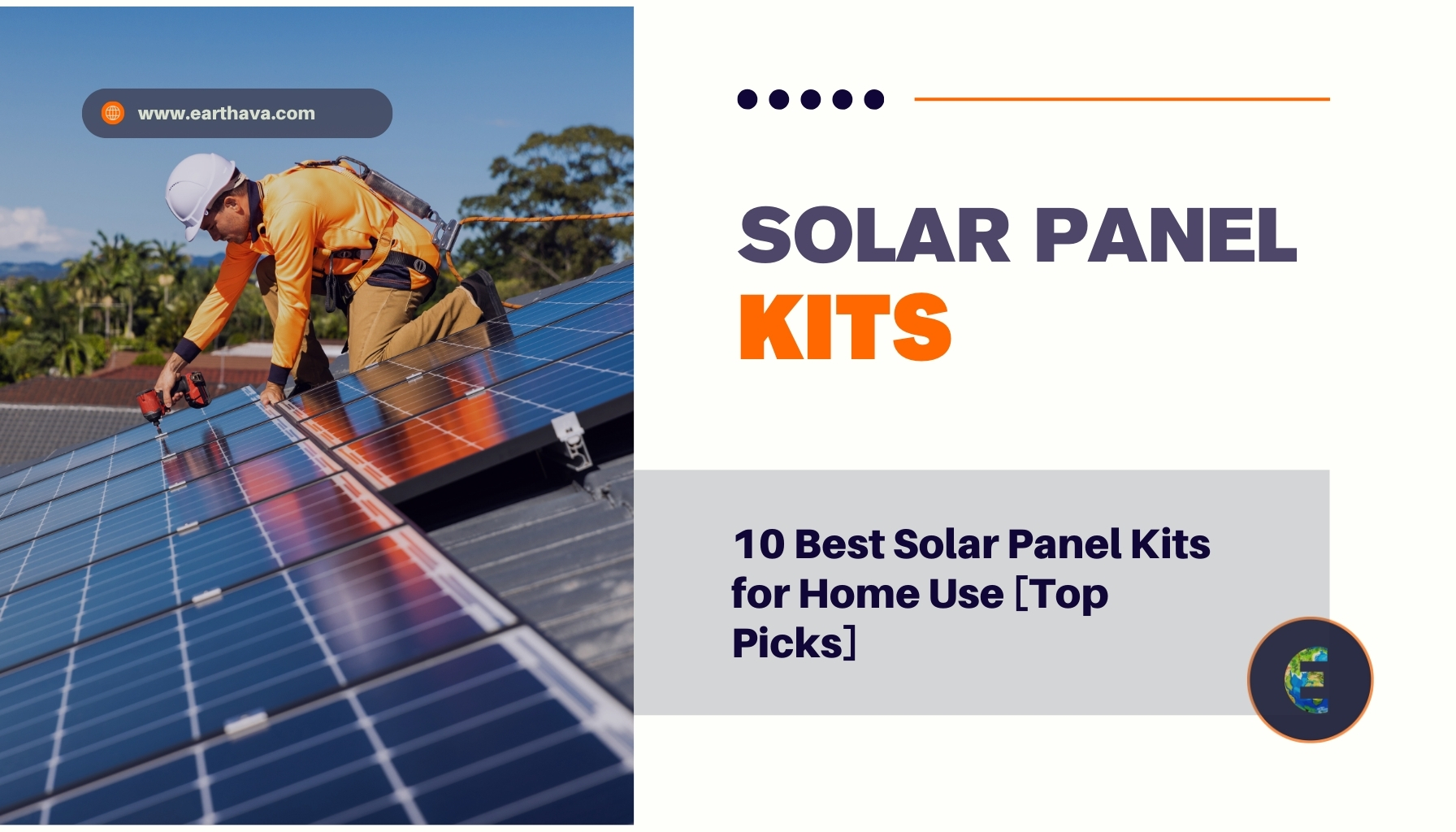
The 10 Best Solar Panel Kits For Home
With the rise and adaptation of solar technology, DIY solar panel kits are available in a wide variety. Here are the 10 best solar panel kits for your home. They are classified into two sections:
- Complete off-grid solar panel kits for homes and small businesses.
- Solar panel Kits for RVs, Boats, Batteries, and Gadgets.
1. SunPower Equinox System (SunPower Went Bankrupt)
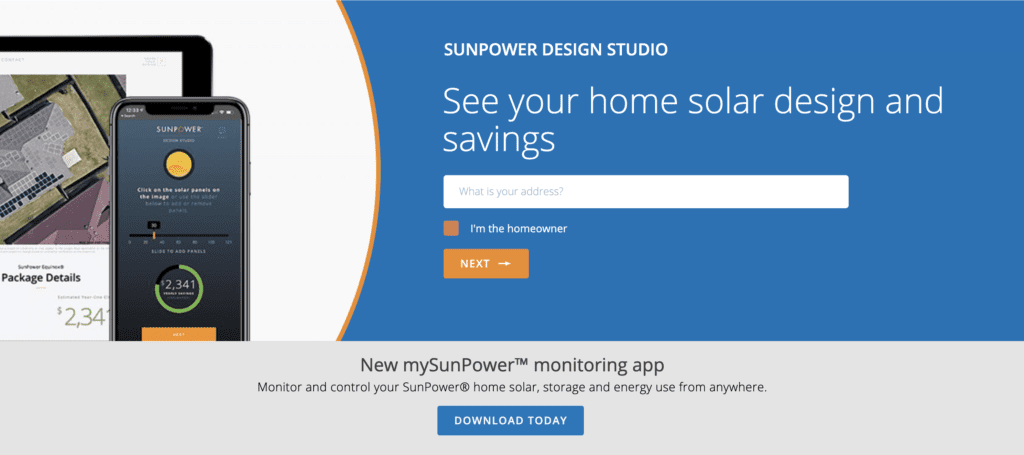
Why we like it: The whole product of one company is offered as a quite efficient and reliable system. From solar panels to the inverter to the storage, all designed by one company, makes it an ideal choice. The ability given to the buyer to design his or her own solar system is unique. Also, a 25-year warranty on the whole system is something not readily available with every company. The microinverter as a design standard makes the complete system run easily for at least 25 years, as compared to the 12-year life of a string inverter.
Editor’s rating: 4.5/5
Equipment specifications for customized installations
- Solar panels: In-house made panels like X-series with 96 Mono-crystalline Maxeon Gen III solar cells are perfect for residential installations.
- Inverter: A microinverter like Enphase IQ 7X for each X-series panel.
- Panel Mounting: Proprietary InvisiMount Frame makes itself invisible, holding the panels and microinverter
- Monitoring system: Complete electricity generation and consumption analysis available from the EnergyLink app.
- Energy storage- SunPower SunVault energy storage system is designed perfectly for the Equinox system
Design
The proprietary solar system from SunPower is more of a customized offering. It depends on the space available and the type of load you are connecting to the system. The company claims 55% more energy than conventional solar panels installed in the same place for the same time scale.
The proprietary Maxeon solar cell technology and the solar panels, like the X-series, manufactured in-house, have an efficiency of 21% or more. The copper foundation of the solar cells and, hence, the solar panel makes them more durable and long-lasting. A microinverter, such as the Enphase IQ 7X, converts the direct current from each solar panel into alternating current near the panel. The microinverter then supplies this energy to the connected load, the grid, or the SunVault energy storage system from SunPower. The battery system powers essential loads for the house or business during a power outage.
Convenient Feature
Most, if not all, components are from the same company, making it more reliable and aesthetically pleasing. The solar panels, microinverters, mounting frames, and energy storage, with the help of a monitoring system, make it an ideal system for homes or businesses. The system generates more power in less space, uses less use of hardware, offers easy connection to energy storage, and offers a lifetime warranty with ease of monitoring are very convenient features.
Pros:
- Very efficient solar panel
- Complete system warranty of 25 years
- Ability to monitor energy generation and consumption
- Ability to supply to the grid
- Ability to store energy if required
- Invisible mounting frame
- Easily expandable
Cons:
- The service will demand higher prices
- Not easy to connect for anyone without experience & skill
This system can be easily customized for anyone. Depending on the load demand and budget of the consumer, the system by SunPower can be very fruitful if we consider “value for money”. High power generation as compared to other available solar systems in lesser space and 25 25-year warranty on almost everything is commendable. This system deserves a 5/5 rating, but the unavailability of costing and assumption of it being on the bit higher side, it is for sure a 4.5/5.
2. 5000 Watt (5kW) DIY Solar Install Kit with Micro-inverters [Rooftop]
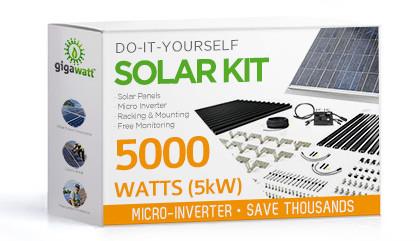
Why we like it: A complete solar panel kit for home and small business use. A combination of monocrystalline solar panels with individual micro-inverters makes an efficient and safe option. Has real-time monitoring to observe power production by the solar kit and consumption at home or supply to the grid. Engineering help by the company to design, install, and commission the solar panel kit is required and available.
Editor’s rating: 4.5/5
Equipment Specifications for 5 kW solar panel kit
- Solar panel: Tier 1 60-cell Monocrystalline solar panel. 17 in number
- Inverter: Enphase micro-inverter, 17 in number
- Panel mounting: IronRidge racking structure.
- Monitoring system.
Design
The Phono Solar 310W, 60-cell, mono-crystalline, all-black solar panel provides approximately 19% efficiency under standard conditions, which is good. A 5 kW system uses 17 solar panels and requires 400 square feet of roof space. Microinverters along each solar panel convert direct current into alternating current for further supply. For a system facing south in the USA or Canada, this system can produce 320-850 units per month if 5 hours of sun are available each day.
The solar panel kit delivers electricity to a junction box, which then distributes it to home loads or sends any excess to the grid through the point of common coupling.
Convenient Features
The micro-inverter is one of the advanced technologies that solves some acute problems of a string inverter. This technology in a solar panel kit on your rooftop makes it safest for generating direct current electricity and instantly converting it to alternating current electricity.
Also, each micro-inverter on each solar panel makes it a separate entity, responsible only for its own current and voltage characteristics. In the case of a string inverter, the whole system operates at the lowest voltage and current as per the shaded or lowest power output solar panel.
You can easily expand the solar panel kit if necessary, required, or desired. Again, one single inverter does not decide the capacity size of the solar system as on its capacity. However, a micro-inverter on a solar panel can expand this easily.
| Wattage | No. of panels | Area required | Average Power Output/month | Price |
| 2kW | 7 | About 160 sq. ft | 175-375 kWh | $4,646 |
| 3kW | 10 | Up to 300 sq. ft | 225-500 kWh | $6,067 |
| 4kW | 14 | Almost 300 sq. ft | 300-750 kWh | $7,777 |
| 5kW | 17 | Up to 400 sq. ft | 350-850 kWh | $9,139 |
| 6kW | 20 | Up to 450 sq. ft | 400-1000 kWh | $10,440 |
| 7kW | 23 | About 500 sq. ft | 450-1200 kWh | $11,766 |
| 10kW | 33 | About 670 sq. ft | 800 – 1800 kWh | $16,200 |
| 15kW | 49 | Up to 900 sq. ft | 1000- 2500 kWh | $23,730 |
| 20kW | 65 | About 1333 sq. ft | 1500- 3000 kWh | $30,851 |
Pros:
- Efficient design.
- Safe and sound.
- Easily Expandable.
- 25-year warranty for the panel and the inverter.
- Ability to monitor energy production.
- Can supply electricity to the grid.
Cons:
- High initial cost.
- Not easy to connect for anyone without experience & skill.
- No storage or battery.
Efficient technology and design make this solar panel kit for those who really want to get full use of the sun’s free resource. This solar kit will not only give financial savings in the long run but also provide energy independence. Also, you will contribute to the fight against climate change.
3. 5000 Watt (5kW) DIY Solar Install Kit with Solar Edge Inverter or Power conditioning unit [Rooftop]
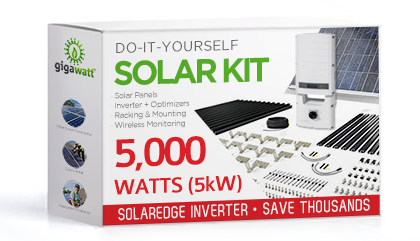
Why we like it: A complete solar panel kit for home and small business use. Power optimizer with maximum power point technology makes it compete with a micro-inverter system in terms of efficiency and performance. The addition of energy storage and monitoring of power generation and consumption is possible in this kit. Installation help is required and is available if you seek.
Editor’s rating: 4/5
Equipment Specifications for 5 kW solar panel kit
- Solar panel: Tier 1 60-cell Monocrystalline solar panel. 17 in number
- Power Optimizer: SolarEdge Power Optimizer with MPPT technology. 17 in number
- Inverter: SolarEdge Inverter
- Panel mounting- IronRidge racking structure.
- Monitoring system
Design
The 310-watt PhonoSolar 60-cell monocrystalline solar panels, which appear all black in color, are efficient in solar energy conversion to electrical energy. A 5 kW solar panel kit uses 17 panels connected to form an array. Each solar panel connects to a power optimizer, which refines the DC current and sends it to the battery or inverter. The inverter converts DC to AC and delivers it to the load or the connected grid.
For a 5 kW solar kit facing south in the USA or Canada, getting 5 hours of sun each day for a month can generate 350-850 kWh, taking 400 sq ft. of your roof space.
Convenient Feature
A power optimizer connects to each solar panel or module to refine and regulate the direct current generated by the panel. The MPPT (maximum power point tracking) technology optimizes the current and voltage from each panel to its optimum level. Like the micro-inverter, the power optimizer treats each solar panel as a separate entity, and any shade or redundancy in any one solar panel does not affect the output of the whole system.
The power optimizer optimizes the DC, which it then supplies to the string inverter. The string inverter, or centralized inverter, converts DC into AC, which is supplied to the connected load or the grid via the control panel or junction box.
The addition of a battery is also possible in this kit if required. You can also connect Tesla’s Powerwall to the same system, as it is compatible. Having a battery is a nice option if you want to go totally off the grid and use only solar energy as your power source.
| Wattage | No. of panels | Area required | Average Power Output/month | Price |
| 4kW | 14 | Almost 300 sq. ft | 300-750 kWh | $7,486 |
| 5kW | 17 | Up to 400 sq. ft | 350-850 kWh | $8,605 |
| 6kW | 20 | Up to 450 sq. ft | 400-1000 kWh | $10,005 |
| 7kW | 23 | About 500 sq. ft | 450-1200 kWh | $11,088 |
| 8kW | 26 | About 600 sq ft | 500-1400 kWh | $12,604 |
| 9kW | 30 | Over 600 sq ft | 800-1500 kWh | $13,723 |
| 10kW | 33 | About 670 sq. ft | 1000 – 1500 kWh | $15,133 |
| 15kW | 49 | Up to 1200 sq. ft | 1100- 2500 kWh | $22,575 |
| 20kW | 65 | About 1333 sq. ft | 2000- 3000 kWh | $29,240 |
| 30kW | 97 | Over 1800 sq. ft | 3000- 4000 kWh | $43,348 |
Pros:
- Efficient design.
- Energy storage is possible, like a battery.
- Cheaper than micro-inverter technology.
- 25-year warranty for panel and power optimizer.
- Ability to monitor energy production.
- Can supply electricity to the grid.
Cons:
- Not easily expandable.
- Not easy to connect for anyone without experience & skill.
- The life of the inverter is 8-12 years with a possible expandable warranty of 20 years.
- The life of the battery and its future cost is similar to an inverter.
This solar kit is efficient and can provide an electricity supply to the home or a small business. The power optimization makes it an advanced system as compared to systems having a direct connection of the solar panel array and string inverter, thus improving efficiency and performance. The string inverter, being the most mature and reliable technology, does not comply with the life of the whole system like a micro-inverter, and also diminishes the possibility of expanding the system. On the other hand, a possible battery connection makes it an ideal choice for homes or businesses in need of power backup. Also, if you want to use energy generated during the day at night, having a battery is a great option.
4. 5000 Watt (5kW) DIY Solar Panel Kit with String Inverter [Rooftop]
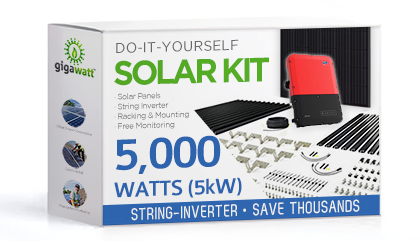
Why we like it: The most common and mature technology in solar power generation, where solar panels are directly connected to the inverter and supply electricity to loads or the electricity grid. This solar panel kit can satisfy home and small business consumption. A monitoring option is also available with this solar panel kit. Above all, it is one of the cheapest options to generate solar power due to the lack of other power refining equipment. Monocrystalline panels connected to a Sunnyboy string inverter satisfy all of your needs if the sun is present in ga ood amount for you without any shade.
Editor’s rating: 3.5/5
Equipment Specifications for 5 kW solar panel kit
- Solar panel: Tier 1 60-cell Monocrystalline solar panel. 17 in number
- Inverter: SMA Sunny Boy grid-tied string inverter
- Panel mounting- IronRidge racking structure.
- Monitoring system
Other components required are to be bought from your nearest Home Depot, for which a list will be provided.
Design
The PhonoSolar 60-cell monocrystalline solar panels, 17 in number for the 5 kW system, are connected to the Sunny Boy string inverter. Direct current or DC from solar panels connected is supplied to the string inverter, and DC power is converted to AC power. Through a junction box or control panel, this electricity is supplied to loads at home or to the electricity grid if generation is more than being used at home.
A 5 kW solar panel kit facing south in the USA or Canada, getting 5 hours of direct sun each day, can produce 350 – 850 kWh in a month.
Convenient Features
The simplicity of the whole design of this system is its benefit. The ease and speed of installation and no use of costly components like micro-inverters or power optimizers reduce the price of the whole system. The string inverter with integrated MPPT technology refinement of current and voltage from the whole system. This makes it work in a much more efficient and cheap manner.
| Wattage (kW) | No. of panels | Area approx required | Average Power Output per month | Price range |
| 3kW | 10 | Almost 250 sq. ft | 200-500 kWh | $5,183 |
| 4kW | 13 | Up to 300 sq. ft | 300-750 kWh | $6,299 |
| 5kW | 17 | Up to 400 sq. ft | 350-850kWh | $7,228 |
| 6kW | 20 | About 450 sq. ft | 400-1000 kWh | $8,124 |
| 7kW | 23 | About 500 sq ft | 450-1200 kWh | $8,930 |
| 8kW | 26 | Over 600 sq ft | 500-1400 kWh | $10,235 |
| 9kW | 30 | About 650 sq. ft | 550 – 1500 kWh | $11,205 |
| 10kW | 33 | Over 700 sq. ft | 1000-1500kWh | $12,178 |
| 15kW | 49 | About 1600 sq. ft | 1400- 3000 kWh | $17,804 |
| 20kW | 65 | Over 2000 sq. ft | 2000- 3000 kWh | $22,863 |
Pros:
- Efficient solar panels
- Cheaper than other technologies like micro-inverters and power optimizers
- 25-year warranty on solar panels
- Ability to monitor energy production
- Ability to supply electricity to the grid
- Energy storage possible
Cons:
- Less efficient than micro-inverter and power optimizer technologies
- Not easily expandable
- Life of inverter 8-12 years or 20 years with an expandable warranty
- Not easy to connect for anyone without experience & skill
This solar panel kit for home or business use can satisfy their energy needs, depending on the size of the system and connected load. The simplicity in design of the whole system makes it a cheaper option, but also less efficient. If solar energy resources are available in good quantity and you need your system to pay back early, this is a good option.
String inverter technology is more than 40 years old now, but it is still not as efficient as new technologies like micro-inverter and power optimizer. Also, expanding the system is not easily possible until you change your inverter. The size of the solar array generating electricity needs to satisfy the size of the string inverter, and any addition or removal of solar panels has to be synchronized with the string inverter.
Energy storage is also possible in this kit, but a charge controller is required to manage energy storage by batteries. Connection to the electricity grid also enhances the viability of this solar panel kit, with the added advantage of selling electricity to the grid and gaining additional monetary benefits.
5. (6000W) Solar Panel Ground Mount Installation Kit

Why we like it: A similar and cheaper version of roof-mounted solar panels connected to a string inverter. A 144-cell monocrystalline 400W solar panel is an efficient choice for home and business use. If ground space with direct sunlight is available with no shade or sunlight obstruction, this is a nice option.
Stable and easy design of the system makes an addition to the unused space, or can also be used as a car shed or for any such activity.
Editor’s rating: 3.5/5
Equipment Specifications for 6kW solar panel kit
- Solar panel: Tier 1, 144 cells mono-crystalline solar panel, 15 in number
- Inverter: SMA Sunny Boy string inverter
- Panels mounting- IronRidge ground mounts, racking structure.
- Monitoring system
Design
The ground mount solar system is an ideal choice if you have plenty of unused ground space near your home or business location.
The Phono Solar 400-Watt monocrystalline solar panel is one of the best solar panels on the market. The manufacturers claim an efficiency of around 19.9%, which is very impressive. These panels generate direct current and supply it to the string inverter. The stable and secure SMA Sunny Boy inverter then converts it to alternating current and supplies it to the load or the grid.
Convenient Feature
This solar panel kit requires no changes to the roof structure of your home or business. If you have enough space, you can generate the maximum amount of electricity you want. The efficient panels and inverter, once installed, will generate electricity and supply power for their lifetime.
The simple and easy design of this solar panel kit makes it an ideal choice for people with unused space and low investment, with an efficient generation profile, making it quick to pay back its investment.
| Wattage (kW) | No. of panels | Area approx required | Average Power Output per month | Price range |
| 3kW | 8 | Almost 300 sq. ft | 300-750 kWh | $4,852 |
| 4kW | 10 | Over 300 sq. ft | 300-750 kWh | $6,049 |
| 5kW | 13 | Up to 400 sq. ft | 350-850kWh | $7,228 |
| 6kW | 15 | About 460 sq. ft | 400-1000 kWh | $8,123 |
| 7kW | 18 | About 500 sq ft | 450-1200 kWh | $9,503 |
| 8kW | 20 | Up to 600 sq ft | 500-1400 kWh | $10,696 |
| 9kW | 23 | Over 600 sq. ft | 800- 1400 kWh | $11,785 |
| 10kW | 25 | Over 650 sq. ft | 1000-1467kWh | $13,157 |
| 15kW | 38 | Over 900 sq. ft | 1500- 2000 kWh | $20,322 |
| 20kW | 50 | About 1333 sq. ft | 2000- 3000 kWh | $27,644 |
| 30kW | 75 | Over 1800 sq. ft | 2400-4200 kWh | $41,695 |
| 40kW | 100 | Over 2400 sq. ft | 3200-5600 kWh | $52,670 |
Pros
- Efficient solar panel
- Cheaper than micro-inverter and power-optimizer technology
- 25-year warranty on solar panels
- Ability to monitor energy production
- Ability to supply to the grid
- Ability to store energy if required
- Suited for ground mount
Cons
- Less efficient than micro-inverter and power optimizer technology
- Not easily expandable
- Life of inverter 8-12 years or 20 years with an expandable warranty
- Not easy to connect for anyone without experience & skill
- Not suited for rooftop installation
If you have plenty of unused space near your home or business, this is the best option to go for. A bigger installation will give you the advantage of selling electricity to the grid and generating revenue. Being cheap and efficient, this solar kit can give a good return on investment and make you more money, and not only save it.
Summary: The solar panel kits chosen are best for their own usability and the demand of consumers. Each solar kit has its own advantages and disadvantages, which you should consider before choosing one. You need to closely evaluate the amount of energy being used and generated. Additionally, you should acknowledge the investment costs and their return before selecting the best solar panel kit for home or small business purposes.
6. HQST 600-Watt 12-Volt Monocrystalline Solar Panel Kit
Why we like it: This is a compact and powerful design to work as a portable solar electricity generator. The solar power kit comes with a range of accessories required to deliver electricity to the battery in an efficient manner. It can serve as a power backup for homes to power portable devices on the go. Also, this solar kit can be attached to an RV or a camp, or a shed with less electrical load.
Editor’s rating: 3/5
Equipment specification
- Solar panel- 100 Watt x 6 mono-crystalline solar panel (35.6 x 25.9 x 1.2 inch in dimensions)
- Charge Controller- 40 Ampere 12/24V with Maximum Power Point Tracker (MPPT) technology
- Cables and connectors: 20 feet of 12 AWG (American Wire Gauge) cable to connect solar panels in an array and the array to the controller. A pair of Y-branch connectors.
- Junction box: IP65
- Mounting of panels: 6 sets of Z brackets
- Monitoring system: LCD
Design
It is a small and compact design to carry your energy generator along with you. In this, 6 Monocrystalline solar panels with a 100W capacity each supply direct current (DC) with a potential of 12V and a strength of 8A. They do so when exposed to direct sunlight. This DC is supplied from a solar panel junction box and its array through 12 AWG cables to a solar charge controller. The MPPT solar charge controller refines the input of current with controlled input to a battery (you need to buy one). The solar generation by the solar panels and input to the charge controller can be monitored by an inclusive LCD.
Power Output
If 5 hours of direct sun is available to this solar kit each day, it should generate around 2-2.5 kWh of energy, which will be more than 200Ah of battery storage.
Convenient Feature
For any beginner to start experiencing solar power generation, this is a great fit. The small size of the whole system makes it portable and widely usable. An efficient monocrystalline panel with an efficiency of at least 19% is the best fit for portable power generation. Do you need to run a small water pump, fan, or charge mobile devices and laptops? It’ll serve them all.
Pros
- Efficient design
- Compact design
- Portable
- MPPT charge controller
- Ability to monitor electricity production
Cons
- Can only power small loads
- Battery required but absent
- No DC to DC converter to power possible DC loads.
- An inverter is required for AC loads, but no mention.
A very well-designed solar panel kit till the power is out from the charge controller. A good battery bank with an inverter to power AC loads can make this kit a very useful component of every household. It is a cheap and good option to explore solar power and make satisfying use of it.
7. ECO-WORTHY 400W 24V Complete Solar Panel Kit with Battery and Inverter
Why we like it: A complete solar panel kit with battery and inverter. It is just about connecting the system, setting the panels in the sun, and starting to use solar energy. This solar kit can be used as a power backup at home, or sheds, an off-grid power supply to RVs and boats, etc.
Editor’s rating: 3.5/5
Equipment Specification
- Solar panel: 24V, 100-Watt Mono-crystalline solar panel, 4 in.
- Charge Controller: 60A charge controller
- Cables and connectors: 1 pair of 16.4ft 12AWG Solar Cable, 1pc 6.56ft 13AWG Tray Cable and 1 pair of 14inch 5AWG Battery Cable
- Inverter: 24V-110V 1500W Pure Sine Wave Inverter
- Battery: 100 Ah capacity, 2 in.
- Mounting of panels: 4 sets of Z mounting brackets
- Monitoring system: Embedded in the charge controller
Design
This small solar panel kit includes all the necessary equipment to generate solar energy. Monocrystalline panels arranged in an array produce 400W at 24V potential and connect to the charge controller. The charge controller manages the current and delivers it to the battery, which connects to an inverter to convert DC into AC.
Solar panels, mounting, connectors, cables, a charge controller, a battery, and an inverter make it an ideal system at this scale.
Power Output
With 4 hours of full sunshine, the panels generate 1.6 kWh of electricity. However, accounting for losses, the expected output is 1.2- 1.3 kWh. This requires a 100Ah battery capacity, and the number of batteries can be adjusted based on usage.
Convenient Feature
The most convenient feature of this solar panel kit is the design, with all the components required in the solar system. From generation to storage and also the consumption of electricity, makes it a good choice for beginners.
Pros
- Efficient panels
- A complete set of equipment is required to be called a solar kit.
- Compact design
- Ability to monitor power production
- Storage is available as a battery
Cons
- Very small electricity generation
- Not exactly portable
- Not so compact
- No MPPT
A complete solar panel kit with battery and inverter. It is just about connecting the system, setting the panels in the sun, and starting to use solar energy. This solar kit can be used as a power backup at home, or in sheds, off-grid power supply to RVs and boats, etc.
8. Renogy 200-Watt 12-Volt Monocrystalline Solar Starter
Why we like it: This is a minimal starter kit with a 200-watt panel and charge controller. Adding a small battery or directly connecting to the battery of an RV will be sufficient for this kit.
Editor’s rating: 2.5/5
Equipment Specification
- Solar panel: A monocrystalline solar panel with 21% efficiency
- Charge Controller: Renogy Rover 20A Li MPPT charge controller
- Cables and connectors: Renogy 20ft 10AWG Solar Panel Connectors Adaptor Kit and Renogy 8ft 10AWG Tray Cables.
- Mounting of panels: Mounting Z brackets
- Monitoring system: Display in the charge controller
Design
This is a very simple design and easy to install for any beginner. In this, a 200-watt monocrystalline solar panel gives 12V and 16A of DC current to the Renogy Rover charge controller. The MPPT in the charge controller maintains maximum output from the solar panel. The charge controller also manages battery charging with optimum power input to the battery.
Power Output
For 5 hours of full sunshine on the panel, this kit can give about 800 Wh of DC electricity.
Convenient Feature
The efficient solar panel with an MPPT charge controller makes this an efficient solar system. Most of the components required to connect the solar kit are given along.
Pros
- Efficient solar panel
- Compact design
- Portable design
- MPPT technology to increase efficiency
- Ability to monitor power production
Cons
- Very small size
- No battery
- No inverter
- No DC to DC converter
This starter kit, at its price, is good for any beginner who wants to explore solar energy. A small battery and an inverter would have completed it for actual use. At present, using an RV or boat with a battery is possible. Otherwise, a small battery and an inverter are required to complete it.
9. BougeRV 200W 12V Mono-crystalline solar charger
Why we like it: This kit is very specific for use in an RV but can also be used for other outdoor activities with a small battery. The efficient panel in this kit makes it an ideal choice for RV enthusiasts. A number of these solar panels connected together can generate a good amount of electricity. Also, the solar panel in this kit is highly durable and sturdy.
Editor’s rating: 3/5
Equipment Specification
- Solar panel: 180-watt monocrystalline solar panel
- Charge Controller: MPPT charge controller
- Cables and connectors: 20ft. 10AWG solar extension cable
- Monitoring system: LCD display
Design
A very small and efficient design with minimal parts makes it a good choice for small-scale applications. This 180-watt monocrystalline solar panel generates a current at a potential of 12V and 15A. This current is supplied to the MPPT charge controller, which has an LCD display attached to monitor the electricity generation.
Power Output
For 5 hours of full sunshine, this kit should generate 700-800 Wh.
Convenient Feature
The efficiency and sturdiness of the panel and MPPT charge controller refine the current being generated and supplied ahead. The expandable option of this kit makes it a very good choice.
Pros
- Efficient solar panel
- Durable and sturdy
- Compact design
- Portable
Cons
- A very small amount of power generation
- No battery included
- No DC to DC converter
- No inverter
With this price tag, this is what you can get. If invested in this solar kit, a good power generator can be a good option to make good use of it in everyday life.
10. TP-solar Solar Panel Kit 100 Watt 12 Volt Mono-crystalline Off-Grid System
Why we like it: This is a good backup power generator for home and small businesses. Highly efficient solar panels give maximum power to connected loads.
Editor’s rating: 2/5
Equipment Specification
- Solar panel: 100 watts, 12-Volt monocrystalline solar panel
- Charge Controller: PWM or Power Width Modulator
- Cables and connectors: 1 pair 16ft, red and black cable
- Mounting of panels: 4 Z mounting brackets
- Monitoring system: LCD
Design
The monocrystalline panel of 100-watt capacity generates electricity at 12V and 8A. This current is supplied to the PWM charge controller. From there, DC is supplied to the battery and inverter, etc.
Power Output
For 5 hours of full sunshine in a day, this solar kit can generate around 350-400 Wh.
Convenient Feature
The compact design and easy-to-install and connect system are convenient features. Also, this solar kit is expandable, and any possibility of expanding the solar system can be explored.
Pros
- Efficient solar panel
- Compact design
- Portable design
- LCD display
- Expandable
- Economical
Cons
- Less power generation
- No battery
- No inverter
- No DC to DC converter
- Use of PWM as compared to MPPT
The compact design of this kit is something to look for, and at this price, this is a fine deal. Other components need to be connected to make full use of this kit.
9 Things to consider before choosing a solar panel kit
Choosing a solar panel kit for a home or small business can be a bit confusing if there is little or no knowledge about the same. Before purchasing your chosen solar kit options, it’s important to understand what factors to consider when selecting a solar panel kit for homes and small businesses:
Potential Of Solar Resources at Location
The potential of solar resources striking a particular surface on Earth is defined by insolation. It is the solar energy per unit area for a particular time. Understanding the potential of solar energy for a particular location is essential for designing and installing solar energy systems. As a general rule of thumb, locations near the Earth’s equator have high insolation levels compared to locations further north or south of the equator.
Professional solar installers generally use a device called a pyranometer to measure detailed solar insolation levels at a site. Another way to assess the potential of solar radiation in your location is by using the Global Solar Atlas, which helps estimate solar energy output from your site.
Identify Installation Area
After confirming the solar data for your location, the area where solar panels are to be installed should be finalized. For global locations in the northern hemisphere, the panels should face south, and for locations in the southern hemisphere, the panels should face north. Solar panels can be installed on slanting roofs, flat roofs, or the ground.
Solar panels should be totally avoided in shaded areas as they affect the output of the solar system. Also, the accessibility to cleaning the panels is an added advantage. Solar panel installation areas should be carefully selected as these, once installed, should stay there for their lifetime.
Another thing to be considered about the installation of panels is their slant. The solar panels are installed in a slanting manner, as this slant makes them directly face the sun and get maximum solar radiation. Another rule of thumb to keep this slant is to know the latitude of your location and keep the solar panel at or about the same angle as the latitude.
For example, let us say California has a latitude of 36o27’, the solar panel in California, if installed at an angle of 36o from the ground, will directly face the sun.
Define Your Consumption Or Load
What amount of electricity do you consume per day, per month, or per year is a question to make yourself more aware of your energy-consuming habits. It is a fact that energy conservation is also energy generation. To install a solar panel system or any energy-generating system for your home or business should start by defining energy consumption and, if possible, bringing it to a least.
Or how much electricity do you want to consume from your solar system? Or what specific devices do you want to power your solar system? These questions should be answered before installing a solar system. Being aware of your electricity consumption or electricity supply, if available in excess, makes you more energy-conscious. This will not only profit you economically but also make you climate-conscious, leading by example.
So understanding your consumption or load to be supplied by a solar panel kit is essential before choosing one too.
Electricity Storage Or Battery Required Or Not
Having an off-grid system for your home or business is like getting out of the electricity transmission line, which everyone is part of. This requires energy storage technology like batteries, and also very efficient consumption of energy.
If power cuts are not a major issue in your area, which is rare in developed countries, you can opt out of batteries or energy storage. Instead, an on-grid solar system without batteries offers more benefits, as it allows you to supply electricity back to the grid and earn or save extra money.
You can use batteries if you need a backup for power cuts or if you want to use the energy produced during the day at night. Adding a battery to a solar panel system comes with additional costs, so you should carefully consider this option before choosing it.
Type Of Solar Panel Required
There are many types of solar panels being invented and researched. The type of solar panel means the type of semiconducting material used to make a solar cell. A solar panel is comprised of a number of solar cells.
Monocrystalline, polycrystalline, amorphous, and thin-film are the major types of solar panels being commercially used. Of these, monocrystalline and poly- or multi-crystalline solar panels are widely used. Monocrystalline solar panels are made up of single silicon crystal doped silicon cells and are most efficient but costly.
Similarly, poly-crystalline solar panels are made up of more than one doped silicon crystal, these are cheaper and less efficient than mono. Doped silicon here means the silicon cells are added with impurities like phosphorus, which makes them generate electricity when photons of sunlight fall on them.
Amorphous and thin-film solar panels are lighter, cheaper, and require more space to generate electricity than mono and polycrystalline solar cells. You should choose solar panels based on your space, budget, and expected payback period.
Type Of Solar Inverter Required
Solar panels generate direct current or DC, and it is not used in our homes or businesses. DC can charge up batteries directly or equipment that requires DC to operate. To convert DC to alternating current or AC, inverters are used.
There are two types of inverters in the market: string inverters and micro-inverters. A string inverter is connected to an array of solar panels and converts DC to AC, which is supplied ahead. A micro-inverter is attached to each solar panel, which converts DC to AC.
The life of the string inverter is less compared to the micro-inverter, but it is also cheaper than the latter. The inverter is the second most essential component of the solar system after the solar panels and should be chosen carefully. The efficiency and lifespan of the solar system depend on the inverter, which also plays a crucial role when the solar system is connected to the grid.
Efficiency Of Solar Panel System
Solar panels do not transmit all the solar radiation falling on them to the connected load. The efficiency of solar panels, inverters, batteries, wiring, etc, all play their roles in delivering power out of the solar system.
Some solar panel kits claim 15% efficiency, and others claim 20% or more, which all depends on the type of solar panel, inverter, and wiring used. Also, the variation in sunlight during the time of day, months, and seasons varies the output of the solar system. Clouds, dust, and dander play their role too in varying the efficiency of the solar system.
Also, with time efficiency of these components decreases, and they will not give the same output continuously for their lifetime.
Warranty available or not
Solar panel kit suppliers giving warranty assurance on panels is a must when going for such an installation. Solar panel manufacturers claim that 25 years is the working life of solar panels. String inverters can last 10 years, and micro-inverters can go for 20 years. It depends on the type of technology used and the efficacy of the manufacturer on the tested and proving the life of components.
Payback period
How long will it take for the amount invested in the solar panel kit to be returned through electricity generation? This calculation depends on the solar radiation available, the type of solar panel, and other components used. Usually, if you are able to cover the upfront cost of a solar system in 5-6 years, it is the way to go. Also, if it takes 10 years, it is still beneficial.
We have to consider the fact that the solar panel system or kit installed today will generate electricity at the same rate for the next 25 years or so. But the electricity supplied from the grid by your power supplier constantly increases from one year to another.
It is just that your location should not be so solar energy deficient that it takes 25 years or more to pay back for your installation.
It’s Your Turn
Solar energy is widely available in most parts of the world. According to NOAA, 173,000 terawatts of solar energy strike Earth continuously, and it is 10,000 times more than the total global energy use. The availability of solar resources makes it an ideal candidate to be the prime source of energy supply for human consumption.
Solar photovoltaic technology, also termed solar PV, has matured in the past decades. From the initial use of solar panels powering satellites orbiting the Earth to the present use in charging mobile devices with integrated battery technology, this technology has penetrated society. Continuous research and development have increased the efficiency of solar photovoltaic technology and have also brought the prices low enough to compete with conventional electricity.
Anyone should first choose the best solar panel kit for their home based on the amount of money they can invest to produce electricity. Another factor to consider is the amount of space and load available at home or for a small business, which will guide the selection.
We at Earthava strive to answer all queries regarding sustainability and the environment and hope to help you live a sustainable life today and in the future.


